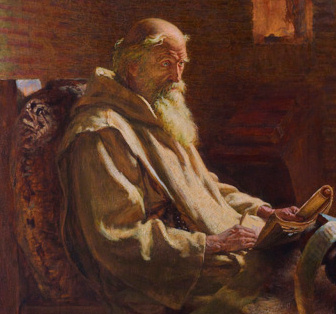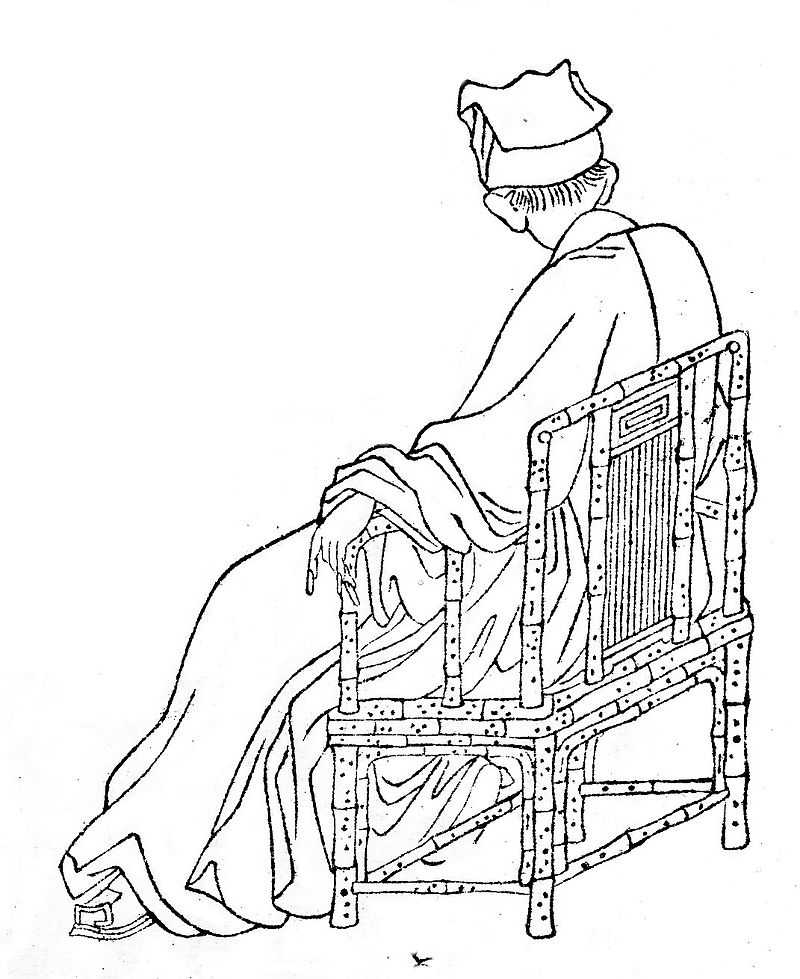Discover our guide to learn about the early culture and beliefs of some of the world’s greatest nations through the best 8th century authors.
The 8th century was a period of great change for several historically significant civilizations. The Assyrian Empire and The Tang Dynasty were at their peaks. Vikings began raiding the coastal areas of Europe and the Mediterranean, marking the dawn of the Viking Age. The Battle of Tours established the rule of the Franks, who would come to dominate Western Europe for nearly a century.
The era’s literature preserves the history of rulers and their battles and sheds light on the customs, belief systems, and daily lives of the people they governed. Today, these early works serve as source documents for historians and sources of ancient truth and wisdom for readers worldwide. If you’re interested in this topic, you might also enjoy our round-up of the best 10th century authors.
Contents
Here Are The 7 Best 8th Century Authors
1. Bede, 673-735

Also known as St. Bede and Bede the Venerable, Bede was just seven years old when he was sent to serve at a monastery. At 19, he was made a deacon. He continued to live and work in monasteries for most of his life. Bede was an author and teacher who was a gifted linguist.
He wrote extensively on theological subjects and translated many of the Greek and Latin works of the early church into English, making them more accessible for Anglo-Saxon study. For his efforts, Pope Leo XIII made him a doctor of the church, a title reserved for people who have made significant contributions to Christian theology through research and writing; he remains the only Englishman to have ever received this title.
Bede’s Ecclesiastical History of the English People is the first written account of the history of the Anglo-Saxons. It begins with Caesar’s invasion and painstakingly describes the kings and clergy whose work formed England’s government and church. It also gives a detailed account of the landscape and people’s daily lives and habits, making it an invaluable record for historians. This work earned Bede the title “Father of English History.”
‘With God’s help, I, Bede … have assembled these facts about the history of the Church in Britain … from the traditions of our forebears, and from my own personal knowledge”
Bede, Ecclesiastical History of the English People
- Bede (Author)
- English (Publication Language)
- 400 Pages - 05/01/1991 (Publication Date) - Penguin Classics (Publisher)
2. Li Bai, 701-762

Li Bai, known by several names, including Li Po, and Li Pai, was born in China’s Sichuan province. As a child, he read extensively, tamed wild birds, and became an excellent swordsman. By age 20, he had fought and killed several men. As a young man, he left his home to travel the Yangtze River and documented his journey and thoughts through poetry. For the next 20 years, he would travel and write until being appointed as an advisor to the Emperor. Li Bai is said to have married four times and fathered many children.
At least 1,000 surviving poems are attributed to Li Bai. His poems are often about the pleasures of drinking wine, engaging in romance and friendship, the joy of solitude, and the beauty of nature. Li Bai’s poems have inspired many western poets, including Ezra Pound and Gary Snyder.
“Hast thou not beheld the mirror in the hall
Li Bai, The Selected Poems of Li Po
That reflects the grief of white hair?
In the morning it is like black silk,
In the evening it will be covered with snow.”
- Hinton, David (Author)
- English (Publication Language)
- 134 Pages - 05/17/1996 (Publication Date) - New Directions (Publisher)
3. Wang Wei

Wang Wei was the eldest of five sons born to an aristocratic family. He is said to have been a precocious child who, at 19, decided to leave home and seek his fortune. He traveled to the capitol and found favor in the Emperor’s court. During the Tang Dynasty, he served as a scholar, statesman, painter, and poet.
Wei’s mother’s death in 747 affected him profoundly. Accounts reveal that he became secluded and wasted away into little more than a skeleton. A violent and lengthy war began after he resumed his duties at the court. Afterward, a weary Wang Wei retired to a villa on the Wang River, where he studied Buddhism and wrote many of his most beloved poems.
There are nearly 400 poems in existence that are attributed to Wang Wei. Much like his paintings, they are primarily focused on the beauty of nature, which accounts for his frequent designation as a landscape poet. His simple short poems are about such small wonders as birdsong and a certain slant of light on river moss. Wang Wei’s poetry has greatly influenced both Eastern and Western writers throughout the centuries.
“As the years go by, give me but peace,
Wang Wei, Poems of Wang Wei
Freedom from ten thousand matters.
I ask myself and always answer,
What can be better than coming home?
A wind from the pine trees blows my sash,
And my lute is bright with mountain moon.
You ask me about good and evil?
Hark on the lake there’s a fisherman singing.”
- Wei, Wang (Author)
- English (Publication Language)
- 128 Pages - 06/28/2006 (Publication Date) - New Directions (Publisher)
4. Du Fu, 712-770

Du Fu, also known as Tu Fu, lost his mother at an early age and was raised primarily by his aunt. He showed a good deal of promise in school, but when he took the imperial exams to earn a spot as a civil servant, he failed. Afterward, he spent several years traveling and writing about his observations. In 746 he met the great poet Li Po, who was several years his elder, an event which greatly inspired him. Not long afterward, he moved back to the capital to attempt a career in civil service once more. He eventually earned a spot, but flood, famine, and war cut his career short.
Eventually, Du Fu moved to a small cottage in the Sichuan province to continue his writing. Often referred to as a poet-historian, Du Fu’s poems meditate on the emotional impact of political, social, and personal events. He frequently juxtaposes everyday events, like watching a tear slide down his wife’s cheek or chickens pecking in the yard, with the tumultuous events of a nation in turmoil.
“I sing what comes to me
Du Fu, Du Fu: A Life in Poetry
in ways both old and modern
my only audience right now—
nearby bushes and trees
elegant houses stand
in an elegant row, too many
if my heart turns to ashes
then that’s all right with me.”
- Du Fu (Author)
- English (Publication Language)
- 256 Pages - 11/04/2008 (Publication Date) - Knopf Doubleday Publishing Group (Publisher)
5. Padmasambhava

Padmasambhava is thought to have been born in the medieval region of India known as Oddiyana, now Pakistan. His origins have been highly mythologized throughout the centuries. Some say he emerged from a lotus blossom as an eight-year-old child. Others say he appeared on the peak of Meteorite Mountain in Sri Lanka.
Custom has it that Padmasambhava was summoned to Tibet from India to help establish its first Buddhist temple. Its construction had been delayed by frequent earthquakes, which were thought to be caused by demons. Padmasambhava is said to have tamed the demons and made them protectors of the temple. While there, he taught and wrote a great deal, and as a result, he is credited with spreading Buddhism to Tibet.
Padmasambhava is said to have written the Tibetan Book of the Dead and hidden it in the hills to be discovered when the time was ripe for its wisdom. It is meant to give readers wisdom for daily life, guidance for encountering death, and healing for the bereaved. The first English translation was not published in 1927. The 1965 publication includes an introduction from Carl Jung, while the 2006 version is prefaced with a forward from the Dalai Lama.
“The moments of our life are not expendable, And the [possible] circumstances of death are beyond imagination. If you do not achieve an undaunted confident security now, What point is there in your being alive, O living creature?”
Padmasambhava, The Tibetan Book of the Dead
- Used Book in Good Condition
- Hardcover Book
- Padmasambhava (Author)
- English (Publication Language)
- 592 Pages - 01/19/2006 (Publication Date) - Viking (Publisher)
6. Ō no Yasumaro, -723

Very little is known about the early life of Ō no Yasumaro. We know that he worked in the civil service and rose through the ranks until he earned the attention of the empress. She commissioned him to use local clan chronicles, myths, and histories to compile the first recorded history of the Japanese people.
A year after he began work, Ō no Yasumaro delivered his completed work, the Kojiki, to the empress. Apart from its value to historians, the book includes myths that laid the foundation for Shinto, Japan’s native belief system. The blend of historical record, myth, and legend make this book an important window into early Japanese culture. Ō no Yasumaro’s grave was discovered in a tea field in 1979, more than a thousand years after his death. The gravestone and the pearls found there are now on display in the museum attached to the Archaeological Institute of Kashihara, Nara Prefecture, Japan.
“Before the heavens and the earth came into existence, all was a chaos, unimaginably limitless and without definite shape or form.”
Ō no Yasumaro, The Kojiki: Records of Ancient Matters
- Ō, no Yasumaro (Author)
- English (Publication Language)
- 279 Pages - 09/09/2014 (Publication Date) - Columbia University Press (Publisher)
7. Paul the Deacon, 720-299

Paul was born to a rich and noble family in Venice. As a young man, he served as a council member in the court of King Desiderius until his kingdom fell to Charlemagne. Paul and his brother participated in a plot against Charlemagne, which resulted in the brother’s imprisonment and Paul fleeing to Duke Arichis II’s court in southern Italy.
Years later, Paul sent a letter and verses to Charlemagne begging for the release of his brother. Charlemagne agreed to the release but insisted that Paul become a part of the group of scholars serving his court. It was during this time that he wrote his History of the Lombards.
The Lombards were a Germanic tribe that settled in Italy during the 4th century. Drawing from their oral tradition as well as various written accounts, Paul’s History of the Lombards is a detailed account of their culture, rulers, and belief systems. It has been translated into numerous languages and is highly regarded for preserving historical details that might otherwise have been lost. Looking for more? Check out our round-up of the best 4th century authors!
“When a certain man, stirred by cupidity, wanted to strip one of them, straight away his arms withered, as is said, and his punishment so frightened the others that no one dared touch them further.”
Paul the Deacon, History of the Lombards
- Used Book in Good Condition
- Paul the Deacon (Author)
- English (Publication Language)
- 352 Pages - 02/01/1975 (Publication Date) - University of Pennsylvania Press (Publisher)